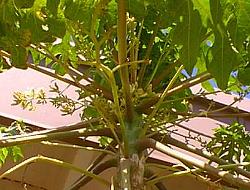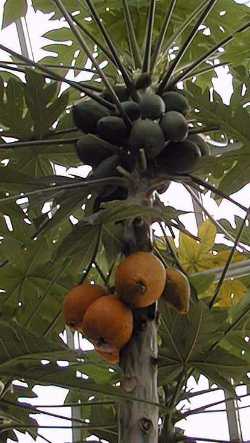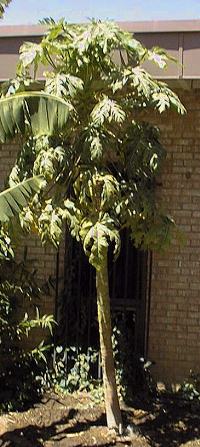Sunset®: 21,23-27
USDA: 10
Frost Tolerance: Tender, needs protection, foliage damaged at 31° F (-0.5° C), serious damage at 28° F (-2° C)
Sun Exposure: Full sun to light shade
Origin: Tropical Americas
Growth Habits: 20 to 25 feet evergreen tree (6 to 7.5 m)
Watering Needs: Regular to abundant water in summer, keep on the dry side in winter
Propagation: Seeds

Papaya male flowers
Technically, the papaya is not a tree but a herbaceous, fast-growing shrub. Plants in general can be characterized as (1) succulent or (2) woody. Succulent plants possessing self-supporting stems (like the papaya and banana) are known as herbs. A papaya seedling 8-inchs tall planted in Phoenix about the first of March will typically grow to a height of 4 to 5 feet by the first of May and Blossoms will be forming in the leaf axils (the spaces between the leaf and stem). It can exceed 7 or 8 feet by October with mature fruit if germination has occurred. The plant blooms continuously throughout its adult life. A papaya is a relatively short-lived plant in its best environment; rarely exceeding four years here where its demise is almost always caused by root rot. The papaya grows best in tropical and subtropical climates where the maximum and minimum temperatures all year stay between 70 and 80 degrees Fahrenheit and the annual rainfall is well over 40 inches. So, what kind of fantasy is this? Growing papayas in a desert with 7 inches of rain and shivering or baking in temperature extremes from 32 to 120? Well, dream on. It’s not so difficult if one can follow a few simple guidelines. Coping with an occasional frost and practicing careful irrigation are the main factors in determining fruition of the dream.
COLD WEATHER PROTECTIONA typical cold snap in Phoenix and the surrounding valley is usually of short duration between 5:00 and 7:00am. On the West Side 29 years, I’ve experienced one low of 15 and several in the range of 29 to 32 degrees Fahrenheit. A sustained low of 33 or 34 will damage foliage.
Brief lows in those ranges are not enough to hurt the root system so don’t worry about protecting it. You don’t have to do anything. There is one measure, however, that you must not take. Do not flood the tree basin as is often advised for the protection of citrus. The soggy soil will cause root rot and the tree will croak before the ground dries.
The stem is tender but I have never seen one damaged by frost. It is easy to protect, anyway. Wrap it with burlap, a blanket or dig some old discarded jackets out of the back closet.
The leaves and crown (growing tip) are quite sensitive and a mild frost will kill them. Usually, a commercial frost cover is sufficient but won’t protect for a long exposure. To get ultimate protection, drive a stake under the frost-cover several inches from the stem and attach a 25-watt light bulb, with an extension cord, of course. The bulb should have a safety shield and electrical devises should never be used in wet weather. Fortunately, it won’t get that cold here during rain. If your tree is thirteen feet tall, try mounting a 100-watt flood lamp, or an infrared, and forget the cover unless you can handle 6-foot stilts. Another effective way to protect the foliage is to aim an air fan into the leaf mass. Use the highest output shop fan you can find and your papaya will be quite safe in all but a severe freeze of long duration. Even then, a fan will minimize the damage.
If you lose all the foliage and growing tip through frost or crown rot, don’t despair. A healthy root system will force branching and each branch has the potential to bear fruit. Some cultures behead their papayas on purpose to increase production.
IRRIGATION
It has been observed that papaya can take all the water you can give it if drainage is ideal. In the Phoenix area, that is probably true only when the soil temperature is above 60 degrees F during the summer. Root rot is certain to set whenever the soil is cold and damp for more than a few days at a time. It is always fatal. There is not much to be done about extended rain but you can plant on a slight mound to direct water away from the root zone. The leaves act as an umbrella deflecting rain toward the drip line. The surface beneath the tree may be covered with plastic but be sure to remove it when the sun comes out again. Once wet, shallow cultivation--using care to avoid wounding roots near the surface at the stem--can help aerate and dry out the soil.
In the months November through February, when soil temperature is below 60 degrees Fahrenheit, papaya growth is very slow or virtually non-existent. The method of irrigation at this time is critical. Water only at the drip line and only when the soil at the drip line is dry an inch beneath the surface. Once established, the papaya has a much greater tolerance to drought than to cold, wet feet.
For winter irrigation, dig a shallow trench 3 inches deep the width and shape of a garden spade around the tree like the imprint of a doughnut with the inner ring directly beneath the drip line. The trench itself will lie outside the drip line. As the papaya grows, extend the trench to keep up with it. Check the ground moisture by scratching an inch or so into the soil. If completely dry, fill the trench with a garden hose at the rate of about a half-gallon per minute. When full, stop. Don’t water again until you scratch and find it quite dry.
The papaya will take full Arizona sun. If the soil temperature is above 55 degrees and drains well (the basin will empty in less than 30 minutes), it is okay to flood irrigate and the tree will respond with fast growth. You can’t believe how fast. When the temperature rises over 90, use good judgement but water often and deeply.
FERTILIZATION
The requirements of papaya are not well established. I have raised over twenty plants to maturity, some with erratic fertilizing and others with none, just water. If there was a difference, I failed to detect it then. Having learned, however, that papayas do respond to nitrogen, I presently feed as follows.
Seedlings until transplanted into one-gallon containers, use 1/4th tsp. per gallon of water-soluble fertilizer with every watering. Plants in one-gallon containers, drench already moist soil every two weeks with about one quart of water mixed at the rate of 1 tbsp. per gallon of 20-20-20. Any commercially available soluble fertilizer is okay. Slow-release plant food I've found to be satisfactory and easiest to apply. Established plants in the ground; salt about a cup of ammonium sulfate monthly or 1/4th cup weekly, around the drip line. Rake it in lightly and water well. Do not add fertilizer to cold, wet soil.
CRFG Fruit Facts recommends 1/4th lb. of 21-0-0 monthly increasing to ½ lb. per month after the plant is established.
VARIETIES
As with most flora, varieties abound. The Mexican papaya appears to be easily grown in the phoenix area. The fruit, that with which I am familiar, is the size of small watermelons. I have not tried to grow it because of personal reasons. I don’t like the taste. Grocery store papayas are generally a Hawaiian grown Solo variety. The common cultivars of the Solo are Sunrise, Sunset, Vista, Waimanolo and X-77 (Kaymia). These vary in disease resistance, size, shape, color of the fruit and size of the tree. None of these features are of any particular value to the recreational home grower in Phoenix and area.
POLLINATION
Your tree may be male, female or hermaphroditic. You won't know until it blooms. Even then it may take some conjecture until the fruit actually sets. There is no mistaking the male. It has clusters of small white blossoms borne on branched tentacles that may be more than 18 inches long. The female has a slightly larger, white blossom borne on the head of a miniature fruit close to the stem in a leaf axil. The petals tend to be straight. If the fruit shrivels after the bloom dies, it has not been pollinated. The hermaphrodite, difficult for the inexperienced to distinguish from the female, has all the necessary sexual paraphernalia in its blossoms to develop fruit. The white petals on this flower have a slight right-hand curvature that is easier to observe while the blossom is still closed. It is best to plant several seeds or seedlings to improve the odds for getting the sex you want. They can be thinned out later.
PLANTING THE SEED
Scoop the seed from the papaya. The seeds are encased in a gelatinous envelope. I find it best to break them and wash the seed thoroughly. I usually mix the seeds--they may number up to 400, with a handful of peat moss. Spread the mix evenly over a tray containing 3 or 4 inches of a good planting mix. Cover that with ½ inch of the same mix. Cover with Saran Wrap until they break the surface, keep the medium damp not wet. Sprouting can take from 15 days to six weeks or longer for some inexplicable reason. Bottom heat always helps. Prick the seedlings out when they are about 2 inches tall and transplant into 4-inch containers in a potting soil that drains well. You will lose a few to damping off. Don’t let that concern you if you plant 100 seeds and you only need 2 or 3 trees. Don’t plant in the ground until the soil temperature is at least 55 degrees F; 70 F is better.
CREDITS
Prepared by Dick Gross, Arizona Chapter California Rare Fruit Growers, Inc. Revised 4/8/99
Internet sources for this material include CRFG Fruit Facts, the University of Hawaii, Texas A & M and the University of Florida with input from members of the Arizona Rare Fruit Growers. In large part, the information is based upon my own experience, flawed though it may be. I am still learning, still experimenting. What I believe today to be facts, I may discover tomorrow to be fallacies. I hope to learn by making more mistakes.

Desert-Tropicals is dedicated to provide gardening advice, gardening ideas, and information about flower of all kind for landscape and collections.We try to check carefully the identification of the plants on the illustrations as well as the other information from the page, but occasionally errors do occur. if you notice anything that needs to be changed please contact us.Thanks.
© 1998-2020 Philippe Faucon, All Rights Reserved.
